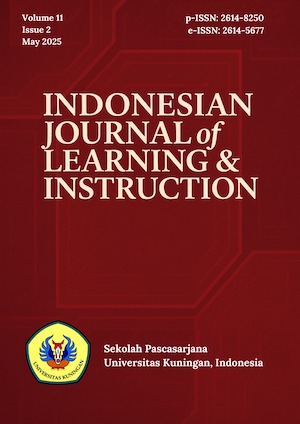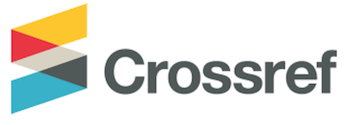INTERACTIONAL MODIFICATION LANGUAGE USED BY THE TEACHER IN ENGLISH CLASSROOM IN MTS PUI CIKASO
Abstract
This research aims at knowing the types of interactional modification language used by the teacher in MTs PUI Cikaso based on Pinter’s theory (2017) and also finding out the students’ responses toward interactional modification. Qualitative research design is applied in this research. The subject of the data is an English teacher and the students of class VII B MTs PUI Cikaso. The data are collected through observation, interview, and questionnaire. During observation, the researcher uses mobile phone to record the learning process by putting the phone in the corner of the class to get clear visualization. The observation is conducted 8 times (8 meetings) where every meeting spends 40 minutes. Interview used to support the data about teacher’s opinion while using interactional modification language. Meanwhile questionnaire is used to support the student’s responses. The data are analyzed both qualitatively. The findings revealed that the teacher used 5 types of interactional modifications: 1) Repetition; 2) confirmation check; 3) comprehension check; 4) clarification request; and 5) reformulation. While for the students’ responses, it showed that the students gave correct responses, incorrect responses, and no response. However, the students admitted that interactional modification language can help them to comprehend material well. It shows that 85% of the students responded positively toward interactional modification used by the teacher. In addition, the interactional modification is being responded negatively by 15% of the students. Finally, the researcher concluded that the use of interactional modification language is needed to keep students-teacher interaction run well.
Keywords: Interactional modification; student’s comprehension; student’s response
References
Abijo, J. A., Azeez, F. A., Odinko, M. N. (2020). Input modification in the teaching of English language among federal university lecturers in South-West, Nigeria. International Journal of Scientific Research in Education. 13(2), 259-270.
Al-Bargi, A., & Al-Ghamdi, H. (2017). The impact of teacher speech modification on the quality of interaction and learning: an analysis of spoken discourse in Saudi EFL classrooms. International Journal of Linguistics. 9(3).
Amin, A. R. (2015). Patterns of teacher – students’ interaction: A case study of classroom interaction in eleventh grade of senior high school in Cimahi. Journal of English and Education, 3(1), 14-29.
Arguelles, D. C., & Rosa, J. P. O. (2016). Do modification and interaction work? – a critical review literature on the role of foreigner talk in second language acquisition. I-Manager’s Journal On English Language Teaching. 6(3).
Aspers, P. (2019). What is qualitative in qualitative research. Qualitative Sociology. 42, 139–160.
Auquilla, D. P. O., Camacho, C. S.H., & Urgiles, G. E. H. (2019). The facilitative role of the interaction hypothesis: using interactional modification techniques in the English communicative classroom. Pol. Con. (Ed. 31), 4(3), 03-23.
Elshadelin, G., & Mardijono, J. J. (2017). Teacher’s interactional modifications and the students’ responses in intermediate English classroom. Journal of Language, Literature, And Teaching. 5(1).
Karima, N., Suherdi, D., & Yusuf, F. N. (2017). Interactional modifications for comprehensible input: A case study of two EFL teachers. Journal of English and Education. 5(2), 170 – 178.
Komba., Sotco., Kafanabo., Njabili., & Kira. (2012). Comparison between students‟ academic performance and their abilities in written english language skills: A Tanzanian perspective. In international Journal of Development and Sustainability 1, 305-325. (www.isdsnet.com/ijds.: 29.04.2016).
Loewen, S., & Sato, M. (2018). Interaction and instructed second language acquisition. Lang Teach, 51(3), 285-329.
Mhandeni, A. S., Mohamed, H. (2016). The role of input simplification and interactional modification strategies in the Tanzanian English-language classroom. Journal of Linguistics and Language Teaching, 7(1).
Munandar, I. (2019). The realization of morphosyntax, pragmatics, phonology in Vivian’s context of English language teaching. Jurnal As-Salam, 3(2).
Nurpahmi, S. (2017). Teacher talk in classroom interaction. ETERNAL English, Teaching, Learning, and Research Journal, 3(1), 34-43.
Pinter, A. (2017). Teaching Young Language Learners (2nd ed.). United Kingdom: Oxford University Press.
Prasetyo, A. (2016). Pengertian penelitian deskriptif kualitatif. Retrieved from https://www.linguistikid.com/2016/09/pengertian-penelitian-deskriptif-kualitatif.html
Rojabi, A. (2019). Penelitian kualitatif (research methodology). Retrieved from https://medium.com/@afdanrojabi/penelitian-kualitatif-research-methodology-4bfaa9ad2912
Sundari, H. (2017). Classroom interaction in teaching English as foreign language at lower secondary school in Indonesia. Advances in Language and Literary Studies 8(6), 147-154.
William, J. Incoe, R. & Tasker, T. (2014). Communication strategies in an interactional context: the mutual achievement of comprehension. In Communication Strategies: Psycholinguistic and Sociolinguistic Perspectives. (pp 304-322). New York: Routledge.









